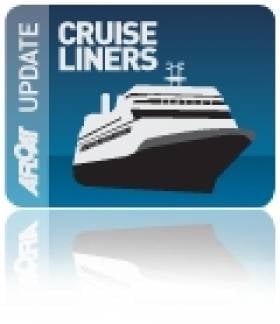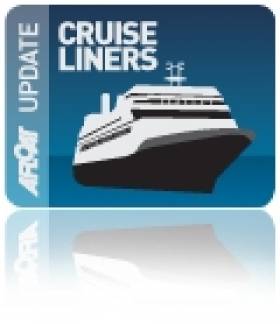Displaying items by tag: Liverpool City Cruise Terminal
Double Role Recalled as Cruiseship Sails South
#CRUISELINERS – Cruise & Maritime Voyages Ocean Countess (17,593 tonnes) departed Liverpool's City Cruise Terminal this evening bound for Cobh, though thirty years ago she sailed considerably further south and for completely different reasons, writes Jehan Ashmore.
The 800 passenger capacity was built in 1976 for Cunard Line as their Cunard Countess which undertook an unusual charter less than a decade later. For six months she was used as a troopship by the British Government's Ministry of Defence after the conclusion of the Falklands War in 1982.
The vessel's deployment was to support troop movements between Ascension Island and Port Stanley whilst the islands airfield at Port Stanley was being reinstated.
She sailed 8,000 miles to the South Atlantic islands, where families and friends of British personnel lost in the conflict were also carried on one round voyage. This was to enable commemorations to take place at sea and ashore. Today marks the end of the war, where further commemorations were held on the islands and in the UK.
#HISTORIC LIVERPOOL CRUISECALL - Cruise & Maritime Voyages (CMV)'s Ocean Countess (1976/17,593grt) became the first turnaround cruise call in four decades after departing Liverpool on Tuesday, however the ship suffered temporary loss of engine power, forcing the vessel to turn around and divert to Holyhead, writes Jehan Ashmore.
The cruiseship with around 700 passengers had embarked during scenes of celebrations as crowds of onlookers gathered for the historic occasion at the Liverpool City Cruise Terminal. Several hours later into the first leg of an eight-night Scottish Isles cruise the incident took place while off the west coast of the Isle of Man.
With the detour to Holyhead, passengers disembarked at the Welsh port and where provided with a shore-side tour excursion programme. Incidentally the Anglesey port welcomed the vessel the previous day, as she made a scheduled call before completing the inbound turnaround at Liverpool.
CMV have scheduled a further ten turn-around cruises from Liverpool this year using the terminal that was completed in 2007 at a cost of £17m. Following Ocean Countess's inaugural turnaround, Princess Cruises considerably larger 3,000 passenger / 113,000 tonnes Caribbean Princess made a call yesterday.
The Liverpool City Cruise Terminal up until now could only accept transit calls as the facility was built with public expenditure. It was deemed otherwise unfair to compete with other leading UK ports with cruise infrastructure facilities that where not funded by the public purse.
In order for the Merseyside to accommodate turnarounds, this was made feasible as Liverpool Council agreed to repay close to €9m of a grant for the river-based terminal in addition build a baggage handling facilities.
Prior to the terminal opening, only small cruiseships could call but instead had to navigate within the dock system to Langton Dock.






























































